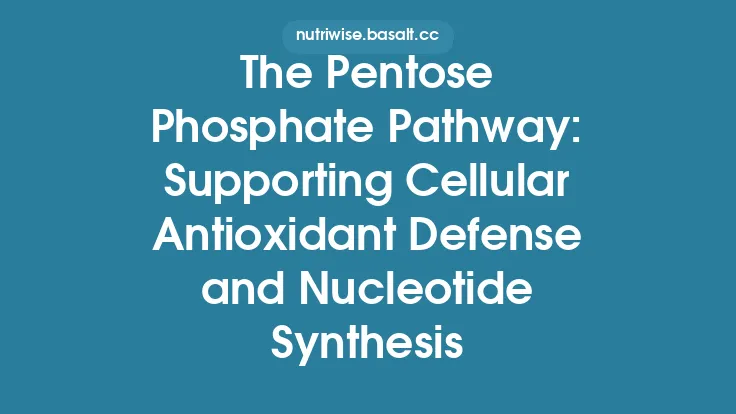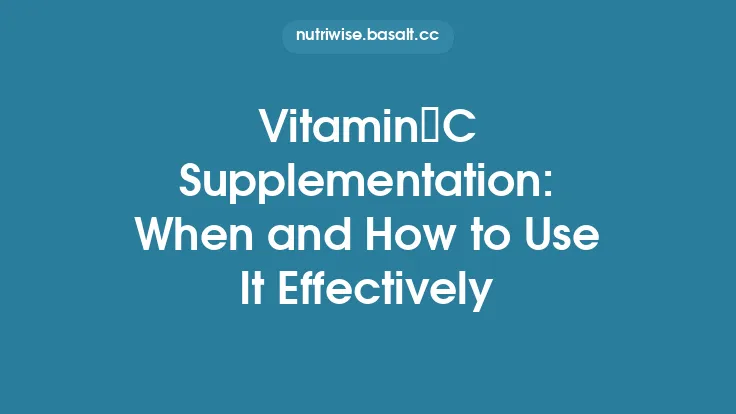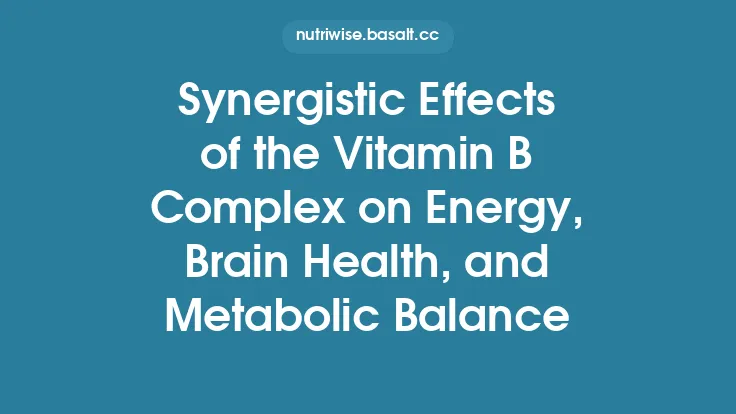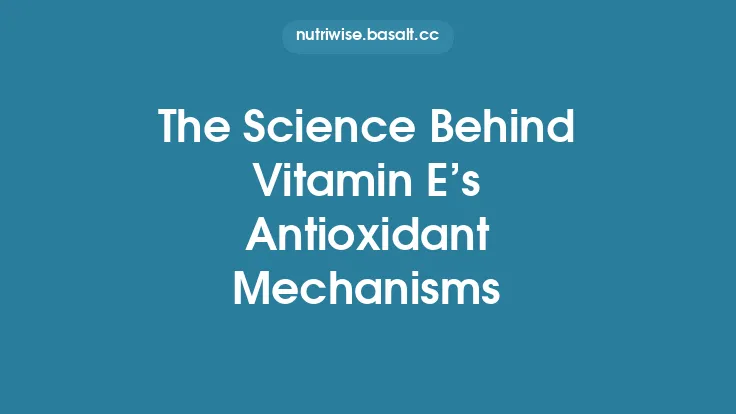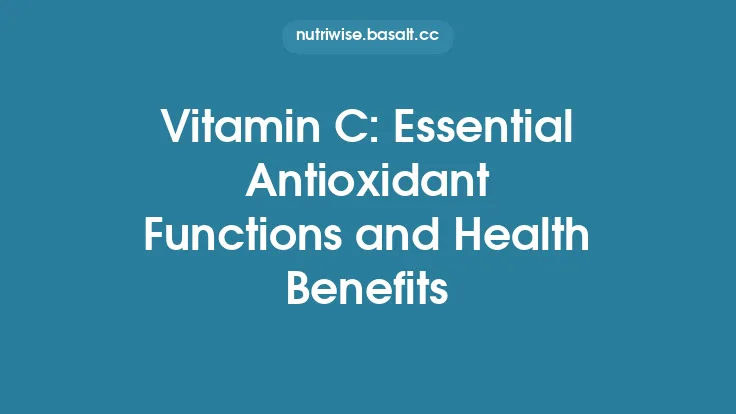Riboflavin, commonly known as vitamin B2, is a water‑soluble micronutrient that plays a pivotal role in the body’s energy‑producing pathways and its ability to neutralize reactive oxygen species. Though required only in milligram amounts, its impact on cellular metabolism is profound because it serves as the precursor for two essential cofactors—flavin mononucleotide (FM N) and flavin adenine dinucleotide (FAD). These flavin cofactors are integral components of a wide array of enzymes that drive oxidative phosphorylation, the citric‑acid cycle, and the detoxification of free radicals. Understanding how riboflavin supports cellular respiration and antioxidant defense provides insight into why adequate intake is critical for maintaining optimal health, especially in tissues with high metabolic demand such as the heart, brain, and skeletal muscle.
Riboflavin: Chemical Structure and Biological Forms
Riboflavin consists of a heterocyclic isoalloxazine ring attached to a ribitol side chain. The isoalloxazine moiety is responsible for the molecule’s redox activity, allowing it to accept and donate electrons in a reversible fashion. In vivo, riboflavin is phosphorylated by riboflavin kinase to form FM N, and subsequently adenylated by FAD synthetase to generate FAD. Both FM N and FAD retain the isoalloxazine core, which can cycle between oxidized (quinone), reduced (hydroquinone), and semiquinone states, making them ideal electron carriers.
Role in Cellular Respiration
Cellular respiration is a multistep process that converts the chemical energy stored in nutrients into adenosine triphosphate (ATP). Riboflavin‑derived flavins are indispensable at several key junctures:
- Complex I (NADH:Ubiquinone Oxidoreductase) – The flavin mononucleotide within Complex I accepts electrons from NADH, forming FMNH₂. This reduced flavin then transfers electrons to the iron‑sulfur clusters and ultimately to ubiquinone, initiating the proton‑pumping cascade that drives ATP synthesis.
- Complex II (Succinate Dehydrogenase) – This enzyme, which bridges the citric‑acid cycle and the electron transport chain, contains FAD as a prosthetic group. FAD accepts electrons from succinate, becoming FADH₂, and subsequently passes them to ubiquinone.
- β‑Oxidation of Fatty Acids – Acyl‑CoA dehydrogenases, which catalyze the first step of fatty‑acid oxidation, are flavoproteins that rely on FAD to abstract hydrogen atoms from acyl‑CoA substrates, generating a trans‑Δ²‑enoyl‑CoA and FADH₂.
- Gluconeogenesis and Amino‑Acid Catabolism – Several dehydrogenases involved in the conversion of lactate to pyruvate (lactate dehydrogenase) and the oxidative deamination of amino acids (glutamate dehydrogenase) are flavin‑dependent, linking nitrogen metabolism to the respiratory chain.
Through these pathways, riboflavin ensures a continuous flow of electrons to the mitochondrial inner membrane, sustaining the electrochemical gradient that powers ATP synthase.
Flavoproteins in the Electron Transport Chain
Beyond Complex I and II, other flavoproteins contribute to the fine‑tuning of oxidative phosphorylation:
- Electron Transfer Flavoprotein (ETF) and ETF‑Ubiquinone Oxidoreductase (ETF‑QO) – These enzymes accept electrons from a variety of dehydrogenases (e.g., those involved in fatty‑acid and amino‑acid oxidation) and funnel them into the ubiquinone pool. Both contain FM N as the primary redox center.
- Monoamine Oxidase (MAO) – Although primarily known for neurotransmitter catabolism, MAO is a mitochondrial outer‑membrane flavoprotein that reduces oxygen to hydrogen peroxide, linking riboflavin metabolism to reactive oxygen species (ROS) generation and signaling.
The ubiquity of flavoproteins underscores riboflavin’s centrality to energy homeostasis across diverse metabolic routes.
Riboflavin‑Derived Cofactors: FMN and FAD
The functional versatility of FMN and FAD stems from their ability to undergo two‑electron (hydride) and one‑electron (radical) transfers. This dual capability enables flavoproteins to:
- Stabilize Reactive Intermediates – The isoalloxazine ring can delocalize unpaired electrons, preventing uncontrolled radical propagation.
- Facilitate Substrate Oxidation – By forming transient covalent adducts with substrates, flavins lower activation energies for oxidation reactions.
- Act as Light‑Absorbing Chromophores – In certain tissues (e.g., the skin), flavins can absorb UV light, contributing to photoprotection mechanisms.
The balance between FMN and FAD pools is tightly regulated by cellular energy status, ensuring that flavin availability matches metabolic demand.
Antioxidant Defense Mechanisms
While riboflavin is essential for generating ROS as a by‑product of respiration, it simultaneously equips cells with tools to neutralize these potentially damaging molecules:
- Regeneration of Glutathione (GSH) – Glutathione reductase, a flavoprotein containing FAD, catalyzes the NADPH‑dependent reduction of oxidized glutathione (GSSG) back to its reduced form (GSH). GSH is the primary intracellular antioxidant, directly scavenging hydrogen peroxide, lipid peroxides, and electrophilic xenobiotics.
- Catalysis of Redox Cycling in Peroxiredoxins – Certain peroxiredoxin isoforms rely on thioredoxin reductase, another FAD‑dependent enzyme, to maintain a pool of reduced thioredoxin, which in turn reduces peroxiredoxins that detoxify peroxides.
- Direct Scavenging of Singlet Oxygen – Riboflavin in its excited state can quench singlet oxygen (^1O₂) generated by photosensitization, converting it back to ground‑state molecular oxygen. This property is especially relevant in ocular tissues and skin, where exposure to light is constant.
- Modulation of NADPH Production – The pentose phosphate pathway (PPP) generates NADPH, a critical reducing equivalent for antioxidant enzymes. Riboflavin‑dependent enzymes such as glucose‑6‑phosphate dehydrogenase (G6PD) are integral to the PPP, linking riboflavin status to the cell’s capacity to replenish NADPH.
Collectively, these mechanisms illustrate how riboflavin not only fuels energy production but also safeguards the very processes that generate ROS.
Interaction with the Glutathione Redox System
Glutathione reductase (GR) exemplifies the intimate partnership between riboflavin and the cellular antioxidant network. The catalytic cycle proceeds as follows:
- FAD Reduction – NADPH donates a hydride to the FAD prosthetic group, forming FADH₂.
- Disulfide Reduction – The reduced flavin transfers electrons to the active‑site cysteine disulfide, generating two thiol groups.
- GSSG Reduction – The thiols attack the disulfide bond of GSSG, reducing it to two GSH molecules while the enzyme returns to its oxidized state.
A deficiency in riboflavin diminishes GR activity, leading to an accumulation of GSSG, a shift in the GSH/GSSG ratio, and heightened susceptibility to oxidative damage.
Riboflavin and Oxidative Stress Mitigation
Experimental models consistently demonstrate that riboflavin supplementation attenuates markers of oxidative stress:
- Lipid Peroxidation – Reduced malondialdehyde (MDA) levels have been observed in riboflavin‑treated rodents subjected to high‑fat diets.
- DNA Oxidation – Lower 8‑hydroxy‑2′‑deoxyguanosine (8‑OHdG) concentrations are reported in cell cultures receiving adequate riboflavin, indicating protection of genomic integrity.
- Protein Carbonylation – Riboflavin enhances the activity of proteasomal and autophagic pathways that clear oxidatively modified proteins, preserving proteostasis.
These protective effects are most pronounced in tissues with high mitochondrial density, reinforcing the link between riboflavin‑driven respiration and antioxidant capacity.
Dietary Sources and Bioavailability
Riboflavin is abundant in both animal and plant foods, though its bioavailability varies:
| Food Category | Representative Sources | Approx. Riboflavin Content (mg/100 g) |
|---|---|---|
| Dairy | Milk, yogurt, cheese | 0.2–0.5 |
| Meat & Poultry | Liver, lean beef, chicken | 0.3–0.9 |
| Fish | Salmon, mackerel | 0.2–0.4 |
| Eggs | Whole egg | 0.2 |
| Vegetables | Asparagus, spinach, broccoli | 0.1–0.3 |
| Legumes | Lentils, soybeans | 0.1–0.2 |
| Grains | Fortified cereals, whole wheat | 0.1–0.3 |
Riboflavin is sensitive to light, heat, and alkaline conditions. Prolonged exposure to sunlight can degrade riboflavin in milk and other transparent liquids, reducing its nutritional value. Cooking methods that involve minimal water (steaming, microwaving) preserve riboflavin better than boiling, where leaching into cooking water can occur.
Recommended Intake and Deficiency Implications
The Recommended Dietary Allowance (RDA) for riboflavin varies by age, sex, and physiological status:
- Infants (0–6 months): 0.3 mg/day
- Children (1–3 years): 0.5 mg/day
- Adolescents (14–18 years): 0.9 mg/day (male), 0.9 mg/day (female)
- Adults (19 years and older): 1.3 mg/day (male), 1.1 mg/day (female)
- Pregnant women: 1.4 mg/day
- Lactating women: 1.6 mg/day
Clinical riboflavin deficiency, though rare in well‑nutrioned populations, manifests as ariboflavinosis—a syndrome characterized by cheilosis (cracks at the mouth corners), glossitis (inflamed tongue), seborrheic dermatitis, and, importantly, impaired oxidative metabolism. Laboratory assessment typically measures erythrocyte glutathione reductase activity coefficient (EGRAC); values >1.2 suggest suboptimal riboflavin status.
Practical Considerations for Optimizing Riboflavin Status
- Balanced Diet – Incorporate a mix of dairy, lean meats, and colorful vegetables to cover the spectrum of riboflavin sources.
- Protect Light‑Sensitive Foods – Store milk and juices in opaque containers and limit exposure to direct sunlight.
- Mind Cooking Techniques – Opt for steaming or sautéing rather than prolonged boiling; retain cooking liquids for soups or sauces to recover leached riboflavin.
- Supplementation When Needed – In cases of malabsorption, chronic alcoholism, or restrictive diets, a riboflavin supplement (typically 5–10 mg/day) can safely restore adequate levels without risk of toxicity, as excess riboflavin is excreted in urine.
- Synergy with Other Micronutrients – While this article focuses on riboflavin, its functions are complemented by niacin (NAD/NADP) and vitamin C, which together sustain redox balance and energy production.
By ensuring sufficient riboflavin intake, individuals support the dual pillars of cellular health: efficient ATP generation through oxidative phosphorylation and robust antioxidant defenses that preserve macromolecular integrity. This synergy underlies the vitamin’s reputation as a cornerstone of metabolic vitality.
